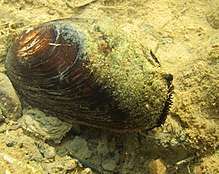Microcondylaea compressa
Microcondylaea compressa is a species of freshwater mussel in the family Unionidae, the river mussels.[2]
| Microcondylaea compressa | |
|---|---|
| A view of valves of Microcondylaea compressa | |
| Scientific classification | |
| Kingdom: | Animalia |
| Phylum: | Mollusca |
| Class: | Bivalvia |
| Order: | Unionida |
| Family: | Unionidae |
| Genus: | Microcondylaea |
| Species: | M. compressa |
| Binomial name | |
| Microcondylaea compressa (Menke, 1830) | |
| Synonyms | |
| |
Distribution
This species is present in southern Europe (Albania, Croatia,[3] Italy, Macedonia and Slovenia).[4][1][5]
Habitat
This species prefers weakly flowing waters, lakes and stagnant waters with fine sandy substrate with some amount of clay. It does not tolerate large excursions of the environmental parameters.[6]
Description
Microcondylaea compressa can reach a length of about 99 millimetres (3.9 in) and a width of 45 millimetres (1.8 in). Shells are quite elongated and laterally compressed. The external surface is light brown to brown with living mussels (empty shells are often coloured dark brown to black) and shows shallow concentric striae of growth. Typical for this species are the tree-like ("arboriform") siphonal papillae - all other European freshwater mussels have undivided papillae. This allows identification of the species without disturbing by touching it even when dug in completely.[6]

Biology
These mussels live completely sunken in sandy or muddy sediment. They mainly feed on phytoplankton and small particles suspended in the water and filtered by the gills. Their life lasts about 5–6 years.[6] The glochidia are - similar to many North American freshwater mussels - released in whitish elongated conglutinates which probably mimic larvae of insects (Trichoptera) and attract possible host fish by this mimicry. There are no confirmed data on host fish species.[7][8]
Conservation status
Microcondylaea compressa has lost many populations in the area during the last century. Main reasons are construction works and changed structures of rivers, dredging of drenches and rivers and chemical pollution. According to IUCN it is classified as "VU" - vulnerable, actual research that the species is critically endangered "CR". Conservation measures should therefore carried out in rivers with viable populations.[9][6]
References
- IUCN
- Biolib
- [Fischer, W. (1999): Microcondylaea compressa (Menke 1828) aus der Mirna bei Istarske Toplice (Istrien, Kroatien). (Bivalvia: Unionidae). – Nachrichtenblatt der Ersten Malakologischen Gesellschaft Vorarlbergs 7: 9–10.]
- Fauna europaea
- [maps.iucnredlist.org/map.html?id=155595]
- Ambiente Regione Emilia-Romagna
- [Nagel, K.-O., Castagnolo, L., Cencetti, E. & Moro, G.A. (2007): Notes on reproduction, growth and habitat of Microcondylaea bonellii (Mollusca: Bivalvia: Unionidae) in the torrente Versa (Italy). - Mollusca, 25(1): 41-49, Dresden.]
- [Reischütz Peter L., Reischütz Alexander (2002): Noch einmal zu Microcondylaea bonellii (A. FERUSSAC 1827) (= Microcondylaea compressa, MENKE 1828), nebst einer kurzen Reflexion über den Sinn der Naturschutzgesetzgebung. – Nachrichtenblatt der Ersten Malakologischen Gesellschaft Vorarlbergs 10: 26–30.]
